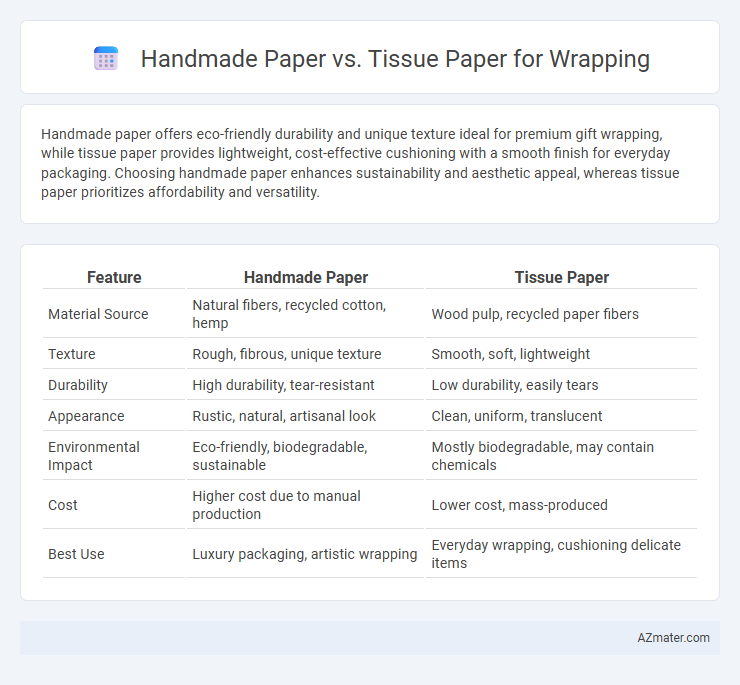Handmade paper offers eco-friendly durability and unique texture ideal for premium gift wrapping, while tissue paper provides lightweight, cost-effective cushioning with a smooth finish for everyday packaging. Choosing handmade paper enhances sustainability and aesthetic appeal, whereas tissue paper prioritizes affordability and versatility.
Table of Comparison
| Feature | Handmade Paper | Tissue Paper |
|---|---|---|
| Material Source | Natural fibers, recycled cotton, hemp | Wood pulp, recycled paper fibers |
| Texture | Rough, fibrous, unique texture | Smooth, soft, lightweight |
| Durability | High durability, tear-resistant | Low durability, easily tears |
| Appearance | Rustic, natural, artisanal look | Clean, uniform, translucent |
| Environmental Impact | Eco-friendly, biodegradable, sustainable | Mostly biodegradable, may contain chemicals |
| Cost | Higher cost due to manual production | Lower cost, mass-produced |
| Best Use | Luxury packaging, artistic wrapping | Everyday wrapping, cushioning delicate items |
Introduction: Handmade Paper vs Tissue Paper
Handmade paper offers a unique texture and durability, making it ideal for premium gift wrapping that emphasizes sustainability and artisanal quality. Tissue paper, known for its lightweight and delicate nature, provides an affordable and versatile option for cushioning and decorative layering. Both materials serve distinct purposes, with handmade paper excelling in eco-friendly aesthetics and tissue paper favored for ease of use and volume packaging.
Origins and Production Methods
Handmade paper originates from traditional techniques involving the manual pulping of natural fibers like cotton and hemp, producing a textured, durable surface favored for artisanal wrapping. Tissue paper, created through industrial processes, uses wood pulp mechanically beaten and pressed to yield thin, lightweight sheets commonly used for delicate wrapping and cushioning. The distinct production methods result in handmade paper's sustainable craftsmanship appeal versus tissue paper's mass-produced, flexible applications.
Material Composition and Texture
Handmade paper is crafted from natural fibers such as cotton, hemp, or recycled materials, offering a sturdy and textured surface ideal for eco-friendly, artisanal wrapping. Tissue paper, typically made from thin, lightweight wood pulp, provides a smooth, delicate texture that is perfect for layering and cushioning fragile items. The fibrous density in handmade paper results in a rougher, more tactile feel compared to the soft, translucent finish characteristic of tissue paper.
Environmental Impact and Sustainability
Handmade paper offers a significantly lower environmental impact than tissue paper due to its use of recycled fibers, minimal chemical processing, and biodegradability, supporting sustainable production practices. Tissue paper often involves intensive bleaching and synthetic additives, contributing to higher carbon emissions and slower decomposition rates. Choosing handmade paper for wrapping enhances eco-friendly packaging by reducing waste and promoting renewable resources in the supply chain.
Aesthetic Appeal and Design Versatility
Handmade paper offers a unique texture and natural fibers that enhance aesthetic appeal with an artisanal, organic look, making each piece distinct and visually intriguing. Tissue paper provides a smooth, lightweight surface available in a wide range of colors and patterns, allowing for greater design versatility in delicate and detailed wrapping projects. The choice between handmade and tissue paper significantly impacts the presentation quality, with handmade paper serving premium, rustic styles and tissue paper excelling in vibrant, intricate decorative effects.
Strength and Durability in Wrapping
Handmade paper offers superior strength and durability compared to tissue paper, making it ideal for wrapping heavier or fragile items. Its fibrous texture provides enhanced tear resistance and cushioning, ensuring better protection during handling or shipping. Tissue paper, while lightweight and flexible, lacks the robustness needed for secure wrapping of durable goods.
Customization Options
Handmade paper offers extensive customization options including unique textures, natural fibers, and eco-friendly dyes that enhance the aesthetic appeal of gift wrapping. Tissue paper provides a wide range of colors, prints, and finishes suitable for high-volume, cost-effective packaging but lacks the textured individuality of handmade paper. Choosing between the two depends on the desired balance between personalized craftsmanship and versatile, budget-friendly wrapping solutions.
Cost Comparison
Handmade paper typically costs more than tissue paper due to its labor-intensive production process and use of natural fibers. Tissue paper is mass-produced using wood pulp, making it more affordable and widely accessible for wrapping purposes. For budget-conscious buyers, tissue paper offers a cost-effective alternative without sacrificing basic functionality.
Gift Presentation and User Experience
Handmade paper offers a unique, textured surface that enhances gift presentation by providing an artisanal and eco-friendly appeal, while tissue paper delivers a lightweight and smooth finish ideal for delicate wrapping and easy handling. The tactile richness of handmade paper creates a memorable unwrapping experience, whereas tissue paper's softness and flexibility ensure secure coverage without bulk. Choosing between these materials depends on the desired aesthetic and practicality, with handmade paper emphasizing elegance and sustainability, and tissue paper prioritizing convenience and subtlety.
Conclusion: Choosing the Ideal Wrapping Paper
Handmade paper offers a unique, eco-friendly option with a textured, artisanal look ideal for premium or personalized gifts, while tissue paper provides lightweight, versatile, and cost-effective coverage suitable for everyday wrapping needs. Selecting the ideal wrapping paper depends on the occasion, budget, and desired aesthetic impact, with handmade paper enhancing presentation and sustainability and tissue paper ensuring practicality and ease of use. Consider the balance between environmental benefits, visual appeal, and functionality to make the best choice for your wrapping purposes.

Infographic: Handmade paper vs Tissue paper for Wrapping
 azmater.com
azmater.com